
E-boys and the emergence of new subcultures
Since their first appearance, e-boys have been subjected to many heated discussions. The popularization of social media and the subsequent emergence of completely new ways of expressing oneself have naturally brought forth new fashion trends and digital identities. Online people can express their styles and ideas much more easily and are less afraid of what others might think. Unfortunately for some, rapid fashion developments on social media also allowed for more recognition, attracting 'opponents' - different subcultures have always clashed.
In this article I examine the e-boy phenomenon, their progression through time, Reddit’s discourse on the common issues around them, and why they have gained such a negative image on today’s social media.
Who are the e-boys?
E-boys are a large community that started to gain traction and recognition in February 2019. They became known for their unusual appearance, which was mocked in memes and reaction videos uploaded by many popular influencers. Though no longer on the rise, e-boys are still a thriving and evolving community. But to understand who an e-boy is, let us look at the definition provided by Urban Dictionary:
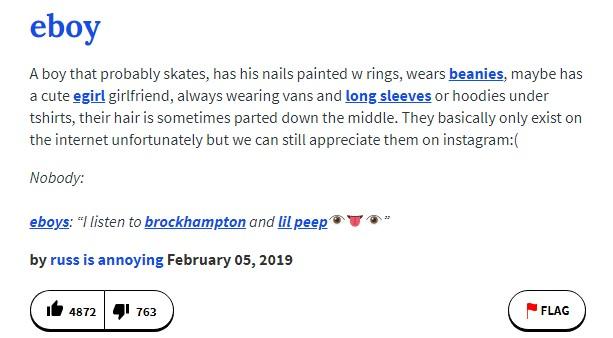
Figure 1: Definition of an e-boy
The letter ’e‘ stands for electronic or emotional, and the opening sentence - ‘a boy that probably skates’ - may not be true in most cases. E-boys indeed took inspiration from the skateboarding community, but the rapid spread of their style reduced its relevance. When "real" skaters saw that e-boys were adopting Thrasher merchandise (a skateboarding brand), they became upset and did not want to be associated with the group.
Identifying e-boys
E-boys make a lot of specific choices when it comes to clothing, as it is their defining feature: sweatshirts or t-shirts tucked into pants with collared or striped long-sleeve shirts underneath, cropped pants or ripped black denim, and black or white shoes, preferably Converse or Vans.
In addition, they love to make use of numerous accessories – silver chains, necklaces, and rings are a necessity when it comes to dressing like an e-boy. Their hair is often dyed and parted down the middle. Band t-shirts are also popular (and subject to heated discussion, see Figure 5).
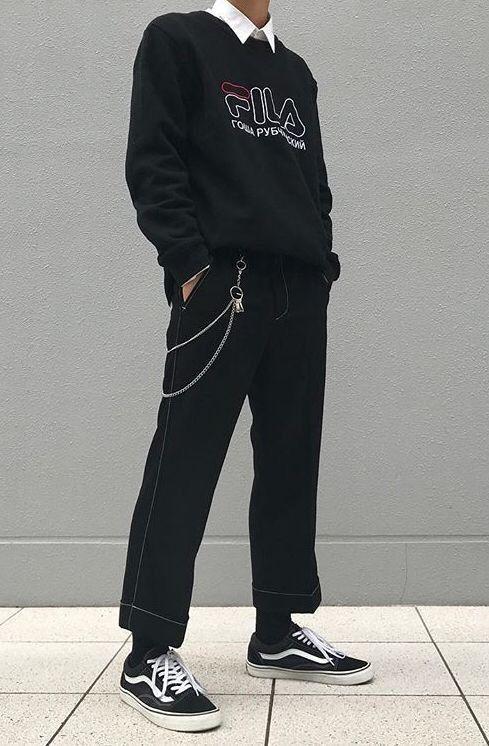
Figure 2: Typical e-boy outfit
Apart from their very distinctive look, they also share a specific musical taste. E-boys usually listen to emo or underground rappers like Lil Peep or $uicideboy$. Furthermore, e-boys are almost required to have a TikTok and Instagram account. Without these apps they would not be able to share their outfits and other content. Social media are also a place for e-boys‘ followers and haters to express their opinion on what the community puts on the Internet.
"Group relations and identities exist predominantly in the mind, but they are shared by many, even if they do not take exactly the same shape in every individual mind within a given ‘community’"
Like every community that emphasizes shared style, e-boys are not limited to wearing black and white or an unnecessary amount of chains. "Group relations and identities exist predominantly in the mind, but they are shared by many, even if they do not take exactly the same shape in every individual mind within a given ‘community’" (Blommaert & Verschueren, 1998). Every person dresses differently, even if it is only a slight modification, and the style evolves with time. Today, ‘generic‘ e-boys are not as visible as people have adopted and adapted the group’s style. Individuality is key for the style's survival and further evolution.
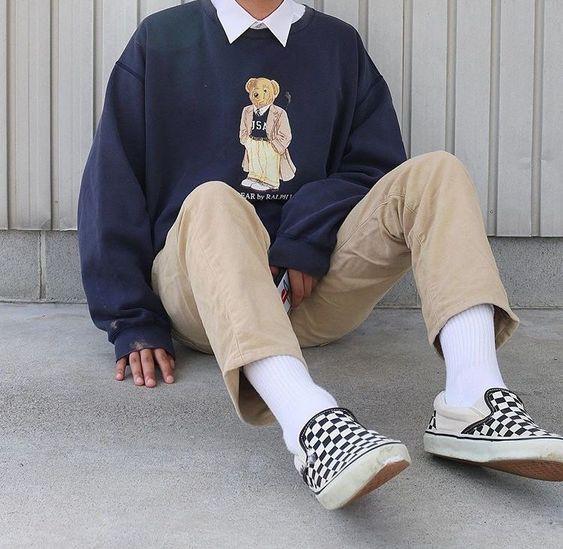
Figure 3: A modern approach
Many styling variations have helped to expand the general idea of an ‘e-boy’, but at the same time diminished the plentiful labels surrounding them. People have generally become more open and accepting, especially given the group's increased stylistic diversity. This phenomenon went in countless directions, further and further blending in with society and moving away from its original form. The stereotypical e-boy is now a rare sight, as the meaning of the term has changed in people's minds and spread to other areas of life.
Since the community originated on the Internet, it is their main source of spreading their ideas and inspiring others to dress like them. Apart from Instagram and TikTok, YouTubers have also contributed to spreading the trend. Even BuzzFeed, a major but controversial news and entertainment site, made a video covering the topic. The number of videos on 'how to dress like an e-boy' and their respective views give perspective on the scale of this Internet phenomenon.
Figure 4: Videos explaining how to become an e-boy
E-boys versus haters
Every major trend on social media is questioned about its style and motives. This is especially the case for e-boys due to the group's lack of visible background or origin. The skateboarding community is partially responsible for e-boys’ style (wide and cropped trousers, skateboarding merchandise), but the discourse below illustrates a lack of connection between the two groups. There is also a second major contributor to the discussion – emo music fans and their objections to e-boys wearing emo bands' T-shirts.
The Reddit post I focus on here was posted to r/teenagers on May 19th, 2019, and received 18 upvotes and 29 comments and is now archived (meaning no one can make new comments or give ratings). Although it did not receive major attention from the subreddit, the author still managed to engage an audience who related to their views and feelings. The poster represents emo music fans who were not, perhaps, audacious enough to write such a rant themselves. Whereas this post focuses solely on music, it also attracted the skater community, who reacted negatively to e-boys wearing Thrasher t-shirts.
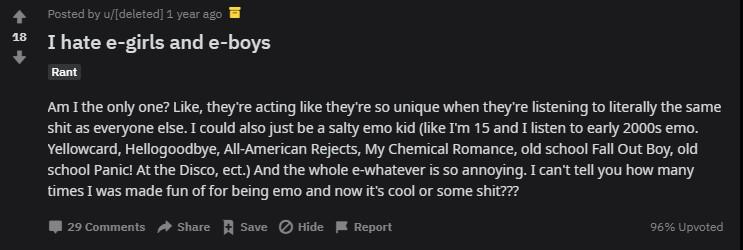
Figure 5: Reddit post ranting e-boys
The rise of the e-boy identity also affected members of other communities. The two main groups that expressed their discontent with e-boys were skaters and emo fans. Their hostile attitude did not come out of nowhere: they felt harmed by ‘outsiders’ who incorporated elements of their style into their own. These groups attempted to 'gatekeep' and 'not allow' others to wear clothes associated with their history and specific interests.
It is important to remember that this case represents a fraction these communities' larger populations. However, "groups and group relations are usually objects of a wide consensus within the groups thus created: they are felt to be natural" (Blommaert & Verschueren, 1998).
Gatekeepers
Gatekeeping creates artficial hostility between different groups and communities. Speaking from my own experience, this is a very common occurrence in the underground rap scene. People often 'hate on' newcomers when a rapper rapidly gains popularity. In this particular case, the gatekeepers are both emo fans and skaters who did not want 'outsiders' to wear something they did not relate to. The 8 upvotes on the last reply also signify a fair amount of agreement on the issue:
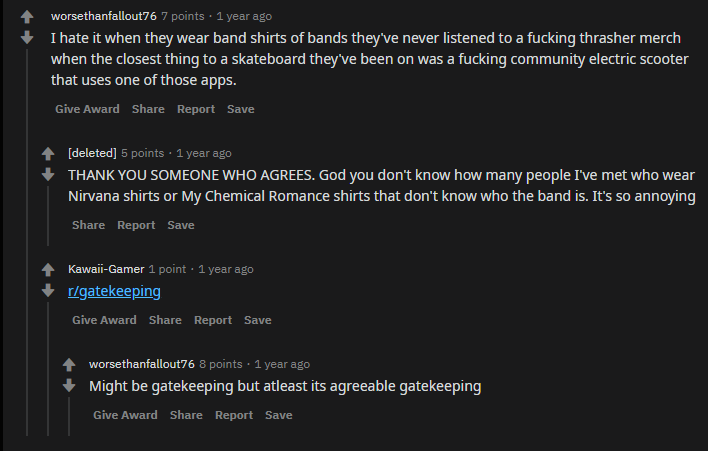
Figure 6: Gatekeeping
Still, a t-shirt is just a garment, even if it carries a message
This thread specifically calls out e-boys wearing clothes associated with emo and skater cultures. It may seem odd to the general public to dislike someone for wearing a band t-shirt. This type of negative approach usually does not extended outside certain subcultures, but has been around for decades. "It is also important to think about how online spaces might build online and offline community in new and different ways around consumer goods and symbols" (Greer & McLaughlin, 2010). Still, a t-shirt is just a garment, even if it carries a message.
Stereotypes and jealousy
Making assumptions about others leads to the creation of stereotypes, and e-boys have plenty of those surrounding them. Painting their nails is often a predominant trait of their style. This might sound like a feminine activity, but usually it is nothing more than a part of their look. However, 'haters' like to insult e-boys by calling them not masculine enough (see Figure 8), drawing on gender stereotypes. E-boys have become an easy target not just for the fashion side of the Internet but also for older, more established subcultures.
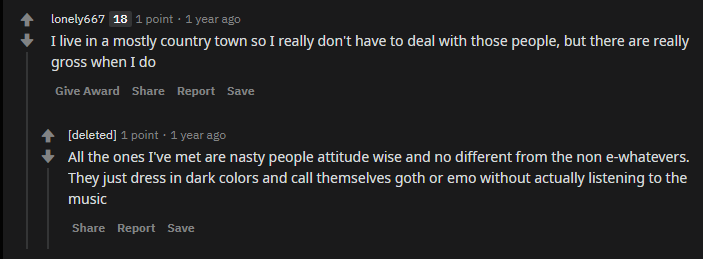
Figure 7: Are e-boys really that gross?
It is interesting to observe that no one comes to the defense of e-boys. This post comes from r/teenagers, a subreddit with over 2.3 million members. There should be plenty of e-boys who would want to respond to these allegations.
Emo fans and skaters are somewhat of a united front in the discussion. They came together to express their criticism of people ‘stealing’ their culture. Emo fans expressed frustration that e-boys wear their t-shirts without being made fun of, despite the fact that emo fans once received the same treatment from "real" punk fans. In the early 2000s, emo music was not liked by many online or offline. The last few years, however, have brought an emo and pop punk revival. But should e-boys be treated like emo fans were?

Figure 8: A person bullied for listening to emo music
Misunderstandings
Searching for one’s own style is often a challenging task. Every person has their own interests, often corresponding to a particular trend or subculture. However, emerging styles are often sites of intense cultural contestation, particular among young people. This discussion shows how a piece of clothing can lead to a completely new issue in the digital world. Social groups' rules are always in flux.
References
Becker, H. S. (1966). Outsiders: Studies in the Sociology of Deviance. Amsterdam University Press.
Blommaert, J., & Verschueren, J. (1998). Debating Diversity: Analysing the Discourse of Tolerance (1st ed.). Routledge.
Greer, C., & McLaughlin, E. (2010). We Predict a Riot?: Public Order Policing, New Media Environments and the Rise of the Citizen Journalist. British Journal of Criminology, 50(6), 1041–1059.